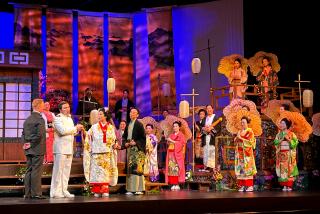A shared geography, but visions are worlds apart
- Share via
Choreographers Bradley Michaud, Linda Lack and Hae Kyung Lee don’t belong on the same program, but their clash of philosophies and styles gave an event titled “Modern Los Angeles Dances” an intense variety if not coherence as part of the free Grand Performances series at California Plaza on Saturday.
Michaud’s program notes for his high-velocity, high-impact Method Contemporary Dance proclaimed “no spoken word or text, no video projection or multimedia display, no play-acting.” Lack’s masked solo rituals emphasized text (program notes of her own), video, multimedia and play-acting to the exclusion of everything else. And Lee’s solo proved subtler in its spirituality than anything Lack offered, as well as brimming with the kind of weightless movement flow that Michaud’s five-member ensemble attempted in slower passages. Very different creators, these three.
Presented in the relatively intimate Marina Pavilion -- a circular, gazebo-like structure on the Olive Street side of the Watercourt -- the performance showcased Lack in four guises. She first appeared in “Trans-Species” as a lizard-like creature slithering around and over a life-size recumbent sculpture by Diane Raymen. She then expired picturesquely in white fur during an excerpt from “Spirit-Wolf” and donned devil-drag for “Mea Culpa (It’s) My Fault,” presiding over video footage of the Iraq war, flinging money ($10,000 “Hell Bank Notes”) at the audience and lashing her long, long tail.
Her own face was visible only in “Ascent -- I Will Not Be Sad in This World” (and then only briefly) as she jettisoned a sense of personal pain for the instant serenity gained from donning a Balinese mask. In style, these solos hark back to the gesture-based, theme-driven work of German modern dance pioneer Mary Wigman, with technical display subordinated to characterization -- though every so often, and especially in her contorted balances, you could appreciate Lack’s exemplary suppleness and refinement.
Where Lack laid everything out expressively, Lee’s “Salm (Revolution)” embraced the enigmatic, showing us a glamorous woman in a backless satin gown of the deepest crimson drifting and floating through time as if seeing nothing but suddenly and unwillingly startled into a sad awareness. Utterly self-absorbed and ultimately unknowable, she danced as if her hands had a life of their own -- fluttering high above her -- and gusts of wind added an unplanned, magical complement to her motion by stirring the drapery panels that hung behind her.
Michaud’s collaborative “Supercedure” has been reviewed in these pages as a full-evening work. The lengthy excerpts on view Saturday confirmed its mastery of a virtuoso style focused on bodies slamming onto the floor as well as its interest in providing a kind of documentary about the interplay of personalities and tensions in a dance company.
Ideas about leadership, personal weakness and all kinds of control informed the dancing, with the company’s wonder women (Sidnie Charnaw, Nicole Cox and Jessica Harper) often leaving Michaud and Jay Bartley in the shade: faultless but not as remarkable.
Where Method chose propulsive rock as accompaniment, Lack used it only for the music of the devil. In “Trans-Species,” Émile Hassan Dyer supplied intricate vocal and percussive effects that sometimes seemed to mock the solemnity of her dancing or at least to invite us to take her less seriously. No such invitation occurred in her other pieces or in Lee’s “Salm,” which sensitively mirrored a score by Robert Een.
--
More to Read
The biggest entertainment stories
Get our big stories about Hollywood, film, television, music, arts, culture and more right in your inbox as soon as they publish.
You may occasionally receive promotional content from the Los Angeles Times.










